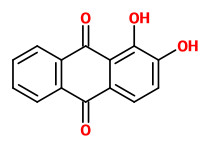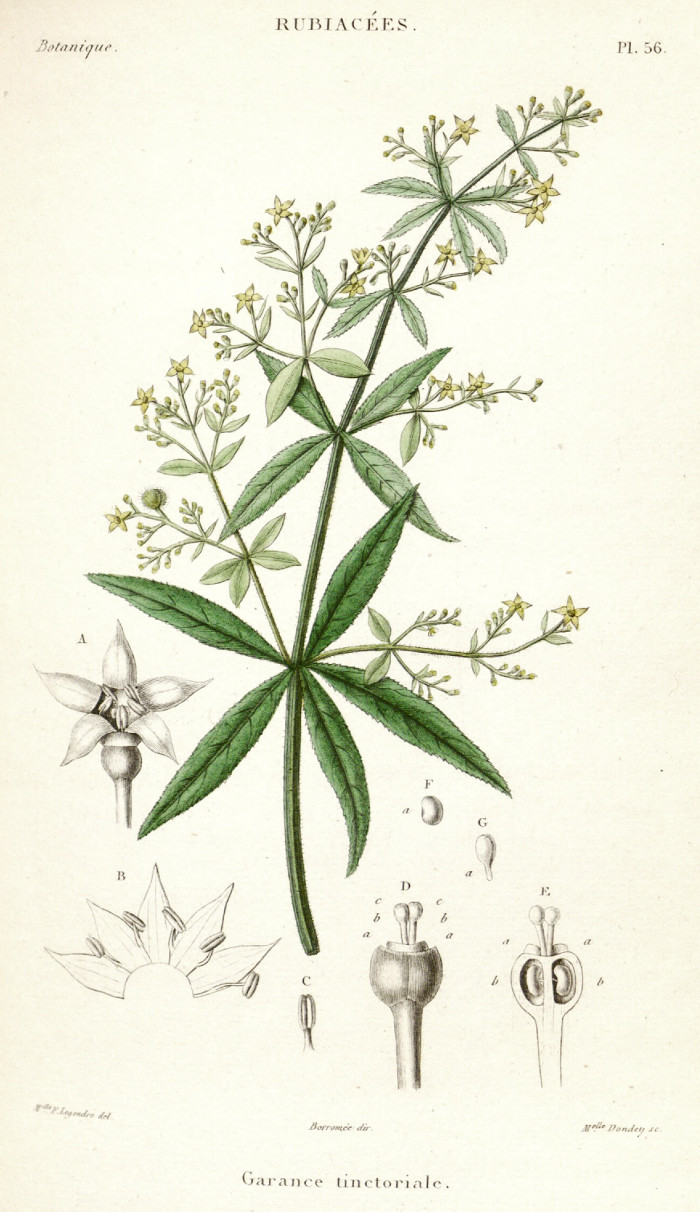Rubia tinctorum L. - syn.Rubia tinctoria Salisbs. - Rubiaceae
dyer's madder, Indian madder, Färberröte, Krapp, Färberkrapp
Perennial evergreen herb, native to Western Asia, East and Southeastern Europe, naturalized in North America; rhizomes stout, woody, red; leaves in whorls of 4-6, papery to subleathery, lanceolate, lanceolate-oblong, or elliptic-oblong; flowers yellow to greenish yellow, rotate-funnelform, glabrous, tube ca. 1mm; berry black, 4×4mm.
„Rubia tinctorum is the madder of commerce, cultivated for the dye derived from its rhizomes and roots, and still used in textiles and fine paints.“
http://www.efloras.org/florataxon.aspx?flora_id=2&taxon_id=220011762
„The plant's roots contain several polyphenolic compounds, such as 1,3-dihydroxyanthraquinone (purpuroxanthin), 1,4-dihydroxyanthraquinone (quinizarin), 1,2,4-trihydroxyanthraquinone (purpurin) and 1,2-dihydroxyanthraquinone (alizarin). This last compound gives it its red colour to a textile dye known as Rose madder. It was also used as a colourant, especially for paint, that is referred to as Madder lake. The substance was also derived from another species, Rubia cordifolia.“ https://en.wikipedia.org/wiki/Rubia_tinctorum
 alizarin (1,2-dihydroxyanthraquinone)
alizarin (1,2-dihydroxyanthraquinone)
„Twenty compounds were isolated from the roots of Rubia tinctorum which are used as a commercial source of madder color. Among these compounds, mollugin, 1-hydroxy-2-methylanthraquinone , 2-ethoxymethyl-anthraquinone, rubiadin, 1,3-dihydroxyanthraquinone, 7-hydroxy-2-methylanthraquinone, lucidin, 1-methoxymethylanthraquinone and lucidin-3-O-primeveroside showed mutagenicity with Salmonella typhimurium TA 100 and/or TA 98.“
[The mutagenic constituents of Rubia tinctorum., Kawasaki, Y., Goda, Y., Yoshihira, K., Chem Pharm Bull.(Tokyo), 40(6), 1992, 1504-1509]
The admission of madder root containing drugs was withdrawn in Germany in 1993.
[Pharm. Ztg. 138 (1993), 834]
„Madder roots contain mainly the primverosides (6-O-β-d-xylanopyranosyl-β-d-glucose) of alizarin (1,2-dihydroxyanthraquinone), lucidin (1,3-dihydroxy-2-hydroxymethylanthraquinone), purpurin (1,2,4-trihydroxy-anthraquinone) and quinizarin (1,4-dihydroxyanthraquinone).“
[Identification and quantification of the constituents of madder root by gas chromatography and high-performance liquid chromatography., Boldizsár, I., Szűcs, Z., Füzfai, Z., Molnár-Perl, I., Journal of Chromatography A, 1133(1), 2006, 259-274] http://www.sciencedirect.com/science/article/pii/S0021967306015664
„Renal cell tumors were also increased with 0.04% alizarin, although at lower incidence than with rubiadin. In addition, glutathione S-transferase placental form-positive liver cell foci and large intestinal dysplasias were significantly increased with 0.04% rubiadin. These results indicate that both rubiadin and alizarin can increase renal preneoplastic lesions, the potential of the latter being weaker. Rubiadin may also target the liver and large intestine, suggesting a major role in madder color-induced carcinogenicity. (Cancer Sci 2009; 100: 2261–2267)“
[Carcinogenic potential of alizarin and rubiadin, components of madder color, in a rat medium‐term multi‐organ bioassay., Inoue, K., Yoshida, M., Takahashi, M., Fujimoto, H., Shibutani, M., Hirose, M., Nishikawa, A., Cancer science, 100(12), 2009, 2261-2267] http://onlinelibrary.wiley.com/doi/10.1111/j.1349-7006.2009.01342.x/full
Dried roots (Radix Rubiae tinctorum, Radix Alizari) are formerly used to treat diseases of the bladder and kidney, as diuretic and antidiarrhoeic. The roots contain anthraquinone glucosides (2-3.5%, mainly alizarin-2beta-primveroside, rubian) which are also absorbed when ingested, and the splittet off di- and trihyhdroxy anthraquinones are excreted through the kidneys. The urine gets a pink color; the substances contained therein have been considered anti-inflammatory and antispasmodic.
[Hagers Handbuch der Pharmazeutischen Praxis, Springer 2010]

Spach,E., Histoire naturelle des végétaux, Atlas (coloured version), t.56 (1834-1847) [M.elle F.Legendre]
http://plantgenera.org/species.php?id_species=889359
